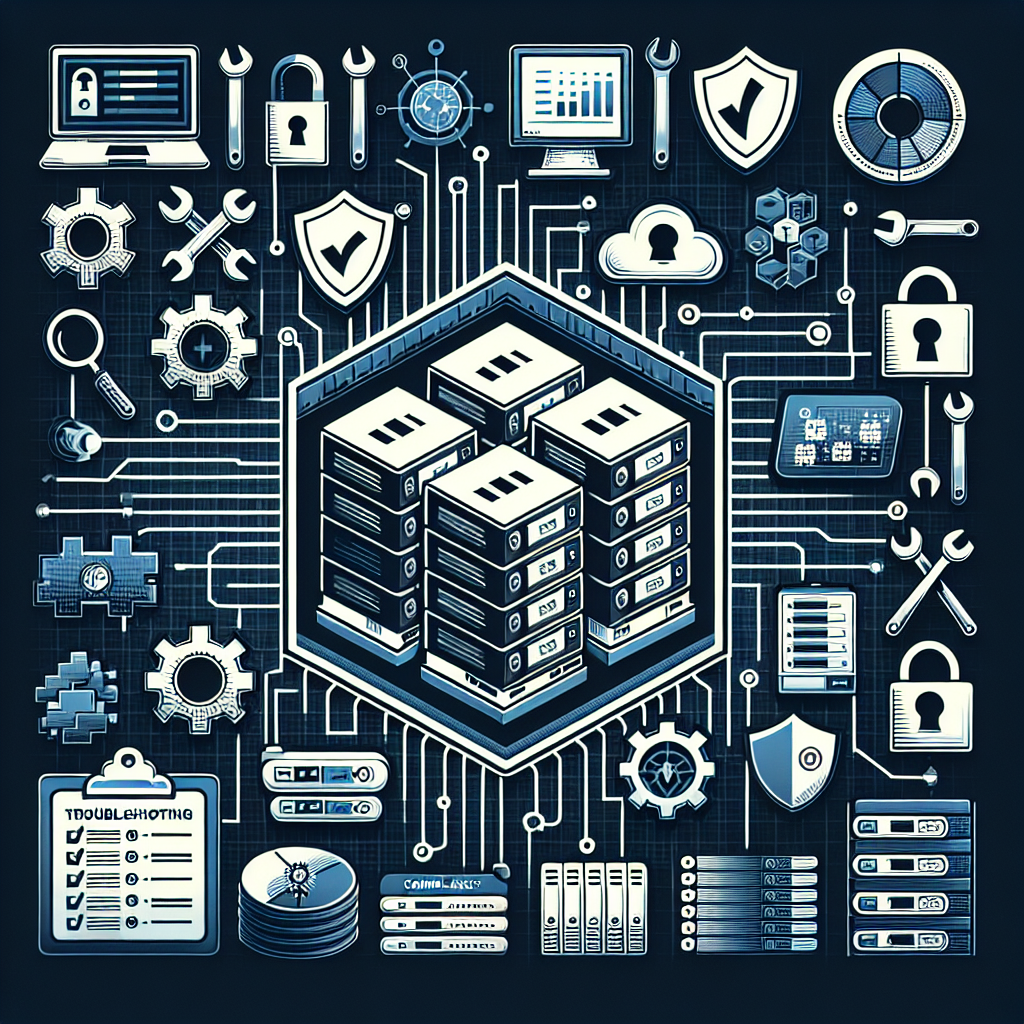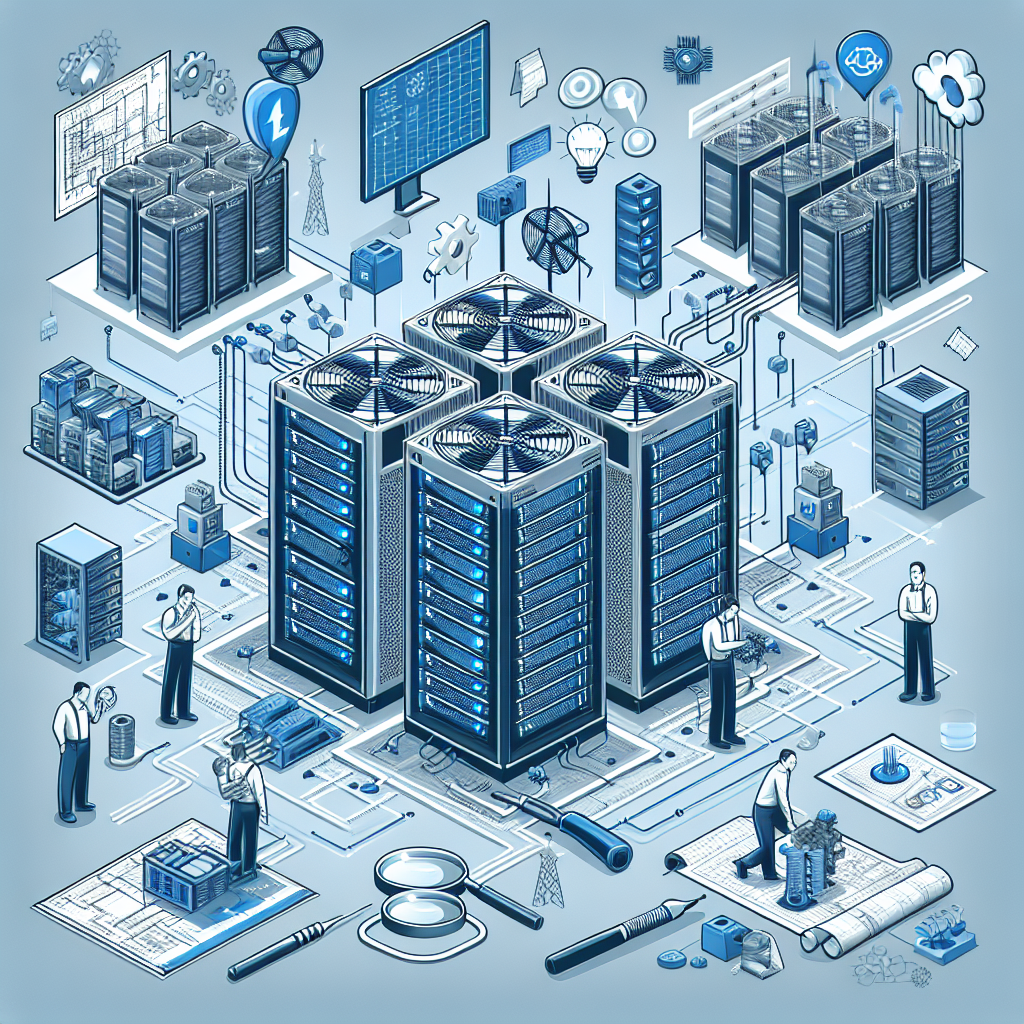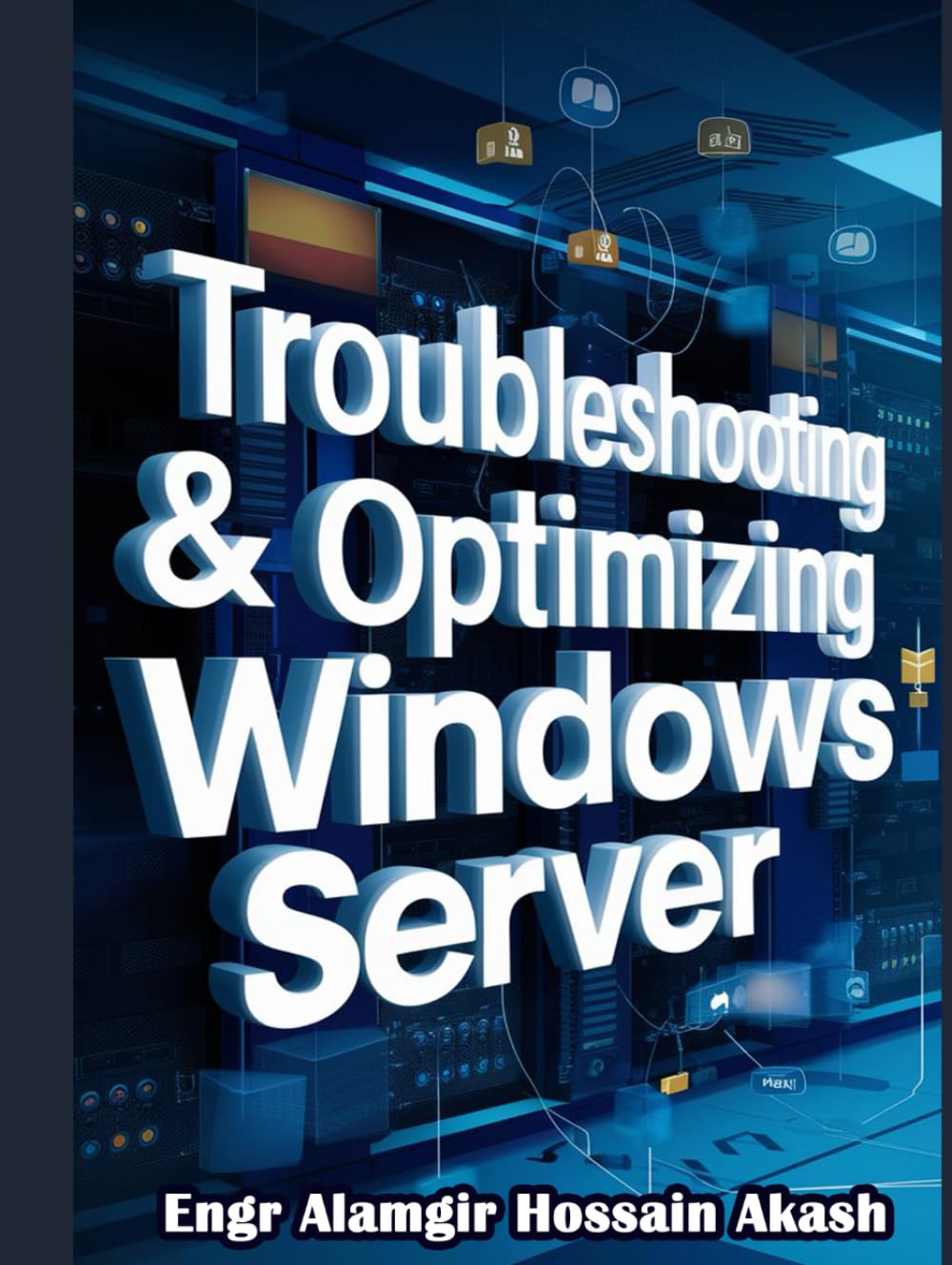Your cart is currently empty!
Tag: Troubleshooting

Troubleshooting Tips for a Smooth Data Center Operation
In today’s digital age, data centers play a crucial role in the smooth operation of businesses and organizations. These facilities house a large amount of critical data and equipment, making them vital to the functioning of various industries. However, like any other system, data centers can encounter issues that may disrupt their operations. To ensure a smooth and efficient data center operation, it is essential to have troubleshooting tips in place to address any potential problems that may arise.Here are some troubleshooting tips for a smooth data center operation:
1. Regularly monitor and maintain equipment: One of the most important troubleshooting tips for data center operation is to regularly monitor and maintain all equipment. This includes servers, cooling systems, power supplies, and networking devices. By conducting routine checks and maintenance, you can identify and address any potential issues before they escalate and cause downtime.
2. Implement a comprehensive monitoring system: To effectively troubleshoot data center issues, it is essential to have a comprehensive monitoring system in place. This system should provide real-time data on the performance and health of all data center components. By monitoring key metrics such as temperature, humidity, power usage, and network traffic, you can quickly identify any anomalies and take proactive measures to address them.
3. Develop a detailed troubleshooting plan: In the event of a data center issue, having a detailed troubleshooting plan can help you quickly and efficiently resolve the problem. This plan should outline the steps to be taken in case of various scenarios, including power outages, hardware failures, and network issues. By having a structured approach to troubleshooting, you can minimize downtime and ensure a smooth data center operation.
4. Conduct regular backups: Data loss can be catastrophic for any organization, so it is crucial to regularly back up all critical data stored in the data center. By implementing a robust backup strategy, you can quickly recover data in the event of a system failure or data corruption. Additionally, having offsite backups can provide an extra layer of protection in case of a disaster at the primary data center.
5. Train staff on troubleshooting procedures: To effectively troubleshoot data center issues, it is essential to have a well-trained and knowledgeable staff. Make sure that your team is familiar with the troubleshooting procedures and protocols in place, and provide regular training to keep their skills up to date. By investing in staff training, you can ensure that your team is equipped to handle any data center issues that may arise.
In conclusion, troubleshooting is an essential aspect of maintaining a smooth data center operation. By implementing these tips and best practices, you can proactively address issues, minimize downtime, and ensure the efficient functioning of your data center. Remember that prevention is always better than cure, so invest in regular monitoring, maintenance, and training to keep your data center running smoothly.

Expert Tips for Troubleshooting Data Center Problems
Data centers are the backbone of modern businesses, housing critical infrastructure and data that powers daily operations. When issues arise in a data center, it can lead to downtime, loss of productivity, and potential data loss. Troubleshooting data center problems requires a systematic approach and expertise to quickly identify and resolve issues. Here are some expert tips for troubleshooting data center problems:1. Monitor and analyze performance metrics: Monitoring performance metrics such as CPU usage, memory usage, network traffic, and storage utilization can provide valuable insights into the health of your data center. By analyzing these metrics, you can identify potential bottlenecks or issues that may be impacting performance.
2. Conduct regular maintenance and updates: Regular maintenance and updates are essential to keep your data center running smoothly. Ensure that all hardware and software components are up to date and functioning properly. This includes updating firmware, applying patches, and replacing any faulty hardware.
3. Check for overheating and cooling issues: Overheating can cause hardware failures and lead to downtime in a data center. Check for proper airflow and ventilation in your data center to prevent overheating. Make sure that cooling systems are functioning correctly and that temperature sensors are monitoring environmental conditions.
4. Review network connectivity: Network connectivity is crucial for data center operations. Check for any network issues such as slow connection speeds, packet loss, or network congestion. Troubleshoot network devices, cables, and configurations to ensure optimal connectivity.
5. Test backup and disaster recovery systems: Data loss can have severe consequences for a business, so it is essential to regularly test backup and disaster recovery systems. Ensure that backups are running successfully, and test restore processes to verify data integrity.
6. Collaborate with vendors and experts: If you are unable to resolve a data center problem on your own, don’t hesitate to reach out to vendors or experts for assistance. They can provide valuable insights and expertise to help troubleshoot and resolve complex issues.
7. Document troubleshooting processes: Keep detailed documentation of troubleshooting processes, including steps taken, solutions implemented, and any lessons learned. This documentation can be valuable for future reference and can help streamline troubleshooting processes in the future.
By following these expert tips for troubleshooting data center problems, you can minimize downtime, ensure data integrity, and keep your data center running smoothly. Taking a proactive approach to troubleshooting and maintenance can help prevent issues before they escalate into major problems. Remember to stay vigilant, monitor performance metrics, and collaborate with experts when needed to keep your data center operating at peak performance.

Troubleshooting Data Center Security and Compliance Concerns
Data centers are the nerve centers of modern businesses, housing critical infrastructure and sensitive data that must be protected at all costs. With the increasing frequency and sophistication of cyber attacks, ensuring the security and compliance of data centers has become a top priority for organizations.However, despite the best efforts of IT teams, data center security and compliance concerns can still arise. When these issues occur, it is important to quickly troubleshoot and address them to prevent potential data breaches or regulatory violations. In this article, we will explore some common data center security and compliance concerns and provide tips for troubleshooting them effectively.
One common concern in data center security is unauthorized access. This can occur when employees or external actors gain access to sensitive data without proper authorization. To troubleshoot this issue, organizations should regularly review and update access controls, ensuring that only authorized users have access to critical systems and data. Implementing multi-factor authentication, encryption, and strong password policies can also help prevent unauthorized access.
Another major concern is data loss or theft. This can happen due to hardware failures, accidental deletion, or malicious attacks such as ransomware. To troubleshoot this issue, organizations should regularly back up data and test their backup and recovery processes to ensure they are effective. Implementing data encryption and monitoring tools can also help detect and prevent data loss or theft.
Compliance concerns are another important aspect of data center security. Organizations must comply with various regulations such as GDPR, HIPAA, and PCI DSS to avoid hefty fines and reputational damage. To troubleshoot compliance concerns, organizations should conduct regular audits and assessments to ensure they are meeting regulatory requirements. Implementing security controls such as data encryption, access controls, and logging and monitoring can help demonstrate compliance to auditors.
In conclusion, troubleshooting data center security and compliance concerns is crucial to protecting sensitive data and maintaining regulatory compliance. By regularly reviewing and updating security controls, conducting audits and assessments, and implementing best practices, organizations can effectively address these concerns and prevent potential security breaches or compliance violations. Remember, data center security is an ongoing process that requires constant vigilance and attention to detail. By staying proactive and responsive to security and compliance concerns, organizations can ensure the safety and integrity of their data centers.

Addressing Data Center Cooling and Power Problems: Troubleshooting Tips
As data centers continue to grow in size and complexity, the need for efficient cooling and power management becomes increasingly important. Without proper cooling and power solutions in place, data centers can encounter a range of issues that can impact performance and reliability. In this article, we will discuss some common problems related to data center cooling and power and provide troubleshooting tips to address them.One of the most common issues data centers face is overheating. When servers and other equipment generate heat, it can quickly accumulate in the data center, leading to high temperatures that can damage hardware and impact performance. To address overheating, data center managers should ensure that they have adequate cooling systems in place. This can include air conditioning units, fans, and other cooling technologies that can regulate the temperature in the data center.
If overheating is a persistent issue, data center managers may need to consider reconfiguring the layout of the data center to improve airflow and ventilation. This can involve rearranging equipment, adding additional cooling units, or implementing hot and cold aisle containment strategies to better manage airflow and temperature distribution.
Another common issue related to data center cooling is power consumption. Cooling systems can account for a significant portion of a data center’s energy usage, so it is essential to optimize cooling systems to reduce power consumption and lower operating costs. Data center managers can achieve this by regularly monitoring and adjusting cooling settings, implementing energy-efficient cooling technologies, and ensuring that cooling systems are properly maintained and serviced.
In addition to cooling problems, data centers may also encounter power issues that can impact performance and reliability. Power outages, surges, and fluctuations can cause downtime and data loss, so it is crucial to have robust power management systems in place. Data center managers should invest in uninterruptible power supply (UPS) systems, backup generators, and surge protection devices to ensure that critical systems remain operational during power disturbances.
To troubleshoot power problems, data center managers should regularly test and inspect power systems to identify any potential issues before they escalate. This can include checking for loose connections, monitoring power usage, and conducting regular maintenance on UPS systems and generators. In the event of a power outage or surge, data center managers should have a comprehensive disaster recovery plan in place to minimize downtime and data loss.
In conclusion, addressing data center cooling and power problems is essential for maintaining optimal performance and reliability. By implementing efficient cooling and power management strategies and regularly monitoring and troubleshooting potential issues, data center managers can ensure that their data centers operate smoothly and efficiently. By following the troubleshooting tips outlined in this article, data center managers can proactively address cooling and power problems and minimize the risk of downtime and data loss.

Effective Tools and Techniques for Data Center Troubleshooting
Data centers are the backbone of modern businesses, housing critical IT infrastructure and data that keep operations running smoothly. However, even the most well-designed data centers can encounter issues that require troubleshooting to resolve. In this article, we will discuss some effective tools and techniques for troubleshooting data center problems.1. Monitoring Tools: One of the most important aspects of troubleshooting data center issues is having visibility into the performance and health of the infrastructure. Monitoring tools such as Nagios, Zabbix, and SolarWinds can provide real-time insights into the performance of servers, network devices, and storage systems. These tools can help identify bottlenecks, anomalies, and potential issues before they cause downtime.
2. Remote Access Tools: When troubleshooting data center problems, it is often necessary to access servers and other devices remotely to diagnose and resolve issues. Remote access tools such as TeamViewer, Remote Desktop Protocol (RDP), and Secure Shell (SSH) can provide secure access to servers and network devices from anywhere, allowing IT teams to troubleshoot issues quickly and efficiently.
3. Diagnostic Tools: In order to troubleshoot data center problems effectively, IT teams need access to diagnostic tools that can help identify the root cause of issues. Tools such as Wireshark, Ping, and Traceroute can help diagnose network connectivity problems, while tools like DiskSpd and CrystalDiskInfo can help identify storage performance issues.
4. Documentation: Keeping detailed documentation of the data center infrastructure, configurations, and troubleshooting procedures is essential for troubleshooting issues quickly and effectively. Documenting network diagrams, server configurations, and standard operating procedures can help IT teams identify potential causes of problems and implement solutions efficiently.
5. Collaboration Tools: Collaboration tools such as Slack, Microsoft Teams, and Zoom can help IT teams communicate and collaborate effectively when troubleshooting data center problems. These tools allow team members to share information, screenshots, and logs in real-time, facilitating faster problem resolution.
6. Change Management Tools: Implementing a robust change management process is essential for preventing and troubleshooting data center issues caused by configuration changes. Change management tools such as ServiceNow and Jira can help track and manage changes to the data center infrastructure, ensuring that all changes are documented and approved before implementation.
In conclusion, effective troubleshooting of data center problems requires a combination of tools, techniques, and best practices. By leveraging monitoring tools, remote access tools, diagnostic tools, documentation, collaboration tools, and change management tools, IT teams can identify and resolve data center issues quickly and efficiently, minimizing downtime and ensuring the smooth operation of critical business operations.

The Importance of Monitoring and Troubleshooting Data Center Performance
In today’s digital age, data centers play a crucial role in the smooth functioning of businesses and organizations. These facilities house a large number of servers, storage devices, and networking equipment that store and process vast amounts of data. As such, it is essential for data center managers to closely monitor and troubleshoot the performance of these systems to ensure optimal efficiency and reliability.Monitoring data center performance involves the continuous tracking of various metrics such as CPU usage, memory utilization, network traffic, and storage capacity. By analyzing these metrics in real-time, data center managers can identify potential bottlenecks or issues that may impact the overall performance of the facility. This proactive approach allows them to take corrective actions before these issues escalate and lead to downtime or data loss.
Troubleshooting data center performance issues is equally important as monitoring. When a problem arises, it is crucial to quickly identify the root cause and implement a solution to restore normal operations. This requires a deep understanding of the underlying infrastructure and the ability to troubleshoot issues across different layers of the data center stack, including hardware, software, and network components.
There are several tools and technologies available that can help data center managers monitor and troubleshoot performance effectively. These include monitoring software that provides real-time visibility into the health and performance of servers and network devices, as well as diagnostic tools that can help identify and resolve performance issues quickly.
The importance of monitoring and troubleshooting data center performance cannot be overstated. Downtime or slow performance can have a significant impact on a business’s bottom line, leading to lost revenue, decreased productivity, and damage to the company’s reputation. By investing in robust monitoring and troubleshooting processes, data center managers can ensure that their facilities operate at peak efficiency and reliability, ultimately contributing to the success of the organization.
In conclusion, monitoring and troubleshooting data center performance is a critical aspect of maintaining the efficiency and reliability of IT infrastructure. By continuously monitoring key performance metrics and proactively addressing issues as they arise, data center managers can ensure that their facilities operate smoothly and effectively, supporting the needs of the business and its customers.

Troubleshooting & Optimizing Windows Server: A Comprehensive Guide to Ensuring Peak Performance and Reliability: Windows Server Performance & Availability Tuning: Essential Tips
Price: $33.99
(as of Dec 18,2024 08:35:10 UTC – Details)
ASIN : B0D8ZSSTBV
Publisher : Independently published (July 7, 2024)
Language : English
Hardcover : 262 pages
ISBN-13 : 979-8332443312
Item Weight : 1.63 pounds
Dimensions : 8.25 x 0.78 x 11 inches
Windows Server is a powerful operating system that is essential for many businesses and organizations. However, like any system, it can experience issues that may impact its performance and availability. In order to ensure peak performance and reliability, it is important to troubleshoot and optimize your Windows Server regularly.Here are some essential tips for tuning the performance and availability of your Windows Server:
1. Monitor Performance Metrics: Use tools like Performance Monitor to track key performance metrics such as CPU usage, memory usage, disk I/O, and network activity. This will help you identify any bottlenecks or issues that may be impacting performance.
2. Optimize Hardware: Ensure that your server hardware meets the recommended specifications for running Windows Server. Upgrade hardware components such as CPU, memory, and storage if necessary to improve performance.
3. Update Drivers and Firmware: Keep your server’s drivers and firmware up to date to ensure compatibility and stability. Check the manufacturer’s website regularly for updates.
4. Disable Unused Services: Disable unnecessary services and features on your server to reduce resource usage and improve performance. Use the Server Manager to manage installed roles and features.
5. Configure Power Settings: Adjust power settings to optimize performance on your server. Use the Power Options control panel to set the appropriate power plan for your server workload.
6. Implement Performance Tuning: Use tools like the Performance Tuning Wizard to optimize performance settings for specific workloads on your server. This can help improve performance and reliability for specific applications or services.
7. Monitor Event Logs: Keep an eye on the Windows Event Logs for any errors or warnings that may indicate issues with your server. Address any critical errors promptly to prevent downtime.
8. Implement Redundancy: Set up redundancy for critical components such as storage, networking, and power supplies to ensure high availability and reliability. Use technologies like RAID, clustering, and failover to minimize downtime.
By following these essential tips for tuning the performance and availability of your Windows Server, you can ensure that your system operates at peak performance and reliability. Regular monitoring, optimization, and troubleshooting are key to maintaining a healthy and efficient server environment.
#Troubleshooting #Optimizing #Windows #Server #Comprehensive #Guide #Ensuring #Peak #Performance #Reliability #Windows #Server #Performance #Availability #Tuning #Essential #Tips
Troubleshooting Data Center Issues: Best Practices and Strategies
In today’s digital age, data centers are crucial for storing and managing vast amounts of information for businesses of all sizes. However, maintaining a data center can be a complex task, and issues can arise that can disrupt operations and cause downtime. It is essential for data center managers to have a solid troubleshooting plan in place to quickly identify and resolve any issues that may arise.Here are some best practices and strategies for troubleshooting data center issues:
1. Monitor and analyze performance metrics: Regularly monitoring key performance indicators such as server utilization, network traffic, and temperature can help identify potential issues before they escalate. By analyzing these metrics, data center managers can proactively address any potential problems and prevent downtime.
2. Implement proactive maintenance: Regular maintenance of data center equipment is essential to prevent issues from occurring. This includes routine inspections, cleaning, and testing of hardware and software systems. By regularly maintaining equipment, data center managers can identify and address potential issues before they cause downtime.
3. Have a comprehensive backup plan: Data loss can be catastrophic for businesses, so having a comprehensive backup plan is essential. Regularly backing up data and having redundancy in place can help minimize the impact of any data center issues that may arise.
4. Utilize remote monitoring and management tools: Remote monitoring and management tools allow data center managers to monitor and troubleshoot issues from anywhere, at any time. These tools can provide real-time alerts and notifications of potential issues, allowing for quick resolution before they impact operations.
5. Implement a disaster recovery plan: In the event of a major data center issue such as a power outage or natural disaster, having a disaster recovery plan in place is crucial. This plan should outline steps for recovering data, restoring operations, and communicating with stakeholders in the event of a crisis.
6. Conduct regular training and drills: Regular training and drills can help data center staff become familiar with troubleshooting procedures and protocols. By simulating different scenarios, data center managers can ensure that staff are prepared to handle any issues that may arise.
In conclusion, troubleshooting data center issues requires a proactive approach and a comprehensive plan in place. By monitoring performance metrics, implementing proactive maintenance, having a backup plan, utilizing remote monitoring tools, implementing a disaster recovery plan, and conducting regular training and drills, data center managers can effectively address and resolve any issues that may arise. By following these best practices and strategies, businesses can minimize downtime and ensure the smooth operation of their data centers.

A Guide to Efficient Data Center Troubleshooting
Data centers are the heart of any organization’s IT infrastructure, housing the servers, storage devices, and networking equipment that keep operations running smoothly. However, when something goes wrong in a data center, it can have serious consequences for the business. That’s why efficient troubleshooting is essential for data center administrators to quickly identify and resolve issues.Here is a guide to efficient data center troubleshooting that can help you minimize downtime and ensure the smooth operation of your data center:
1. Monitor and Analyze Performance Metrics: The first step in troubleshooting data center issues is to monitor and analyze performance metrics. This includes monitoring server CPU and memory usage, network traffic, storage utilization, and other key performance indicators. By keeping a close eye on these metrics, you can quickly identify any anomalies or bottlenecks that may be causing issues.
2. Use Monitoring Tools: Monitoring tools such as Nagios, Zabbix, or SolarWinds can help you track the performance of your data center infrastructure in real-time. These tools can alert you to potential issues before they become critical, allowing you to take proactive measures to prevent downtime.
3. Establish Baselines: It’s important to establish baselines for the performance of your data center infrastructure so that you can quickly identify deviations from normal behavior. By regularly monitoring and comparing performance metrics against these baselines, you can quickly pinpoint the root cause of any issues.
4. Conduct Regular Maintenance: Regular maintenance of data center equipment is essential to prevent issues from arising in the first place. This includes keeping hardware and software up to date, performing routine backups, and ensuring that cooling systems are functioning properly.
5. Document Everything: Keeping detailed documentation of your data center infrastructure, including hardware configurations, network diagrams, and troubleshooting procedures, can save you valuable time when issues arise. By having a clear understanding of your data center environment, you can quickly identify and resolve issues.
6. Follow a Systematic Troubleshooting Process: When troubleshooting data center issues, it’s important to follow a systematic process to quickly identify and resolve problems. This process typically involves gathering information about the issue, isolating the root cause, testing potential solutions, and implementing a fix.
7. Collaborate with Colleagues: Don’t be afraid to reach out to your colleagues or other experts in the field for help when troubleshooting data center issues. By collaborating with others, you can benefit from their knowledge and expertise, leading to quicker resolution of issues.
Efficient data center troubleshooting is essential for maintaining the smooth operation of your organization’s IT infrastructure. By following the tips outlined in this guide, you can quickly identify and resolve issues, minimize downtime, and ensure the reliability of your data center.

Common Data Center Troubleshooting Tips and Tricks
Data centers are the backbone of modern businesses, housing critical systems and infrastructure that keep operations running smoothly. However, like any complex system, data centers can experience issues that can disrupt operations and cause headaches for IT professionals. Fortunately, there are some common troubleshooting tips and tricks that can help quickly identify and resolve issues before they escalate.One of the most common issues in data centers is overheating. Data centers generate a significant amount of heat due to the large number of servers and networking equipment housed within them. If not properly managed, this heat can lead to equipment failure and downtime. To combat overheating, data center technicians should regularly check and clean air filters, ensure adequate airflow around equipment, and consider implementing cooling solutions such as air conditioning or liquid cooling systems.
Another common issue in data centers is network connectivity problems. When servers or networking equipment lose connectivity, it can disrupt operations and cause data loss. To troubleshoot network connectivity issues, IT professionals should start by checking cables and connections to ensure they are secure and undamaged. They should also verify that network settings are correct and that there are no IP address conflicts. Network monitoring tools can also be helpful in identifying and resolving connectivity issues quickly.
Data loss is another common issue that can occur in data centers. Whether due to hardware failure, human error, or malicious attacks, data loss can have serious consequences for businesses. To prevent data loss, data center technicians should regularly back up critical data and test backup systems to ensure they are functioning properly. Additionally, implementing data encryption and access controls can help protect data from unauthorized access.
Finally, power outages can pose a major threat to data center operations. Without power, servers and networking equipment cannot function, leading to downtime and potential data loss. To prevent power outages, data center technicians should invest in uninterruptible power supply (UPS) systems that can provide backup power in the event of an outage. Regularly testing UPS systems and ensuring they are properly maintained can help prevent power-related issues in data centers.
In conclusion, data center troubleshooting can be a challenging task, but with the right tips and tricks, IT professionals can quickly identify and resolve issues to keep operations running smoothly. By addressing common issues such as overheating, network connectivity problems, data loss, and power outages proactively, data center technicians can minimize downtime and ensure the reliability of their systems.
